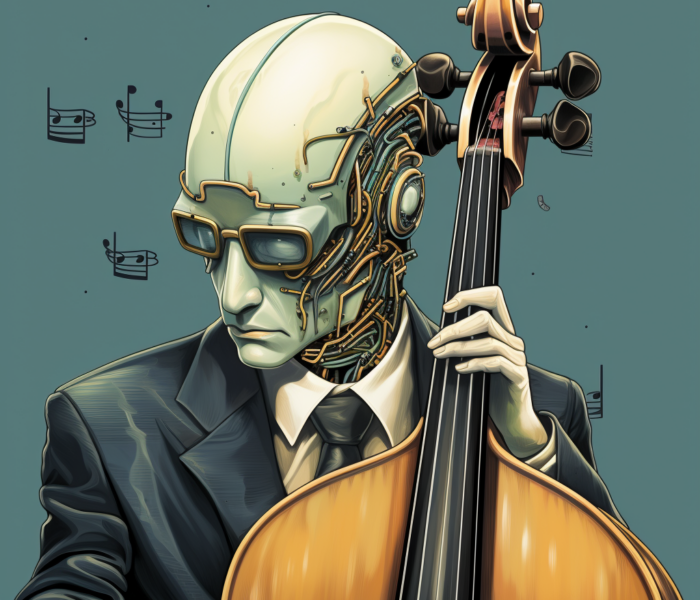Changing media and technologies have always conditioned the way we listen to and create music. To what extent is the "digital metamorphosis" of music and the advent of streaming and playlists compatible with creative music? Here are a few thoughts in random mode.
For as long as recorded music has existed, the technological evolution of supports and formats has determined not only the way music is listened to, but also the way it is created. In the second half of the twentieth century, the album (Long Play or LP) became the equivalent of the opus for Western music with a written tradition: for a pop or jazz musician, creating a work meant composing (and publishing) an album (which could, on occasion, be double, or even, very exceptionally, triple).
Thus, the advent of the CD, which could store up to 80 minutes of music (compared to around 40 minutes for the LP), initially led to an excessive increase in the length of these works: many of the albums released directly on CD in the 1990s were really very, if not too long, unnecessarily talkative, equivalent to a double-album on vinyl - in effect trivializing a format which, in the analog era, remained an exception, regarded with particular attention by critics; to release a double album was then to have something especially important to say.
Then we returned to more usual proportions, and to CDs that could be as short as forty minutes (a record that's too long is always worse than one that's too short; frustration will always be preferable to weariness). For repertoire and experimental music, however, the CD represented a godsend, not only in terms of sound quality, but also because it made it possible to offer longer programs, and above all to finally listen without interruption to pieces - I'm thinking, for example, of certain compositions byEliane Radigue - whose length far exceeded the duration of one or even two LP sides.
It's worth noting that for a long time, the overall evolution of these media was in the direction of constant improvement in sound quality, right up to the CD, which in this respect can be considered as the apogee. Since then, the hegemony of digital technology and the spread of dematerialized music, marked by the listening of increasingly compressed files (mp3s, often of mediocre quality) on increasingly unsuitable devices (cell phones or computers, poor-quality headphones or Bluetooth speakers), has triggered an undeniable decline in quality.
The new criteria now seem to lie elsewhere: in addition to quantity (infinite or near-infinite), what now seems to matter when considering music are its portability and its "instrumental" dimension, in the sense of "utilitarian" - what American music sociologist Tia DeNora calls "scenic specificity"(1), i.e. a music's ability to accompany a particular mood (zen or edgy), situation (a candlelit dinner, a festive evening) or time of day (getting off work, a road trip). In other words, the triumph of the playlist.
The playlist is by no means a new phenomenon: as early as the last century, the advent of the cassette enabled everyone to create their own playlists by copying and juxtaposing tracks from different records. These were known as compilations, and they weren't just the preserve of the "expert listener" of yesteryear, since they also existed in disc form. For lack of any trace on YouTube of the fabulous compilations of the English label E.G., I'm thinking, for example, of this one, published in 1986 by the Brussels label Les Disques du Crépuscule, which has little to envy them in terms of eclecticism, since it includes composers more or less affiliated with minimalism such as Michael Nyman, Gavin Bryars or Harold Budd, as well as bands from the post-punk scene The Durutti Column, A Certain Ratio... :
The album format hasn't waited for the hegemony of streaming and playlists to atomize and shatter it - without losing its canonical dimension. The advent of digital technology would even have the advantage of multiplying the range of possibilities in terms of formats: making it possible to offer very long albums for download, or albums that include images, videos and so on. Nevertheless, in 2016, a study carried out by LOOP (Lots of Online People) among 3,014 American listeners on their music-listening habits revealed that playlists had now overtaken albums - the former accounting for 31% of listening time, compared with 22% for the latter.
Another "ancestral" practice, at least predating the digital age, is "ambient" music. The "scenic specificity" of music is not new, and many music lovers - including yours truly - have not waited for the triumph of transportable playlists to make extensive use of music as background music. In 2017, hipsters on social networking sites laughed out loud at an article in Elle describing the use of " slow listening " - in other words, listening to music or an album without doing anything else.
This "wellness" recycling of a widespread practice among many music lovers was certainly something to smile about. The fact remains that, although there are as many listening regimes as there are individuals, some music lends itself very little to distracted listening, and "creative" music, whether written or unwritten, less so than others. This is mainly due to their strong dynamic variations, which require constant correction of sound levels, in contrast to the sonic uniformity of mainstream music production. Added to this is the fact that streaming platforms such as Spotify and Deezer are totally unsuited to classical and contemporary music, which places no importance on the performers and dooms to failure any attempt to find a particular interpretation of a work.
However, this did not prevent Chartmetric from publishing a study last year on musical practices during the health crisis, entitled COVID-19's Effect on the Global Music Business, Part 1: Genre, which concluded that three musical categories had gained in popularity during the containment period: children's music, classical music (including contemporary music and opera) and what it refers to as ambient, relaxation and experimental music. A result that must certainly be tempered by remembering that composers of piano music by the mile, such as Italy's Ludovico Einaudi ("the man with two billion listens") or America's Max Richter, are considered "contemporary composers". But that's another subject, and the subject, perhaps, for another column.
In many respects, what Fabien Granjon and Clément Combes have called the "digital transformation" of music(2) has radically changed listening habits, especially among the digiborigenes (or digital natives). The dematerialization of formats has been joined by the rise of algorithms, which now order and guide the listening habits of the vast majority of listeners. What is their impact on creative music? To what extent do they leave room for the unexpected and the unheard? More in the next issue.
David Sanson



)



